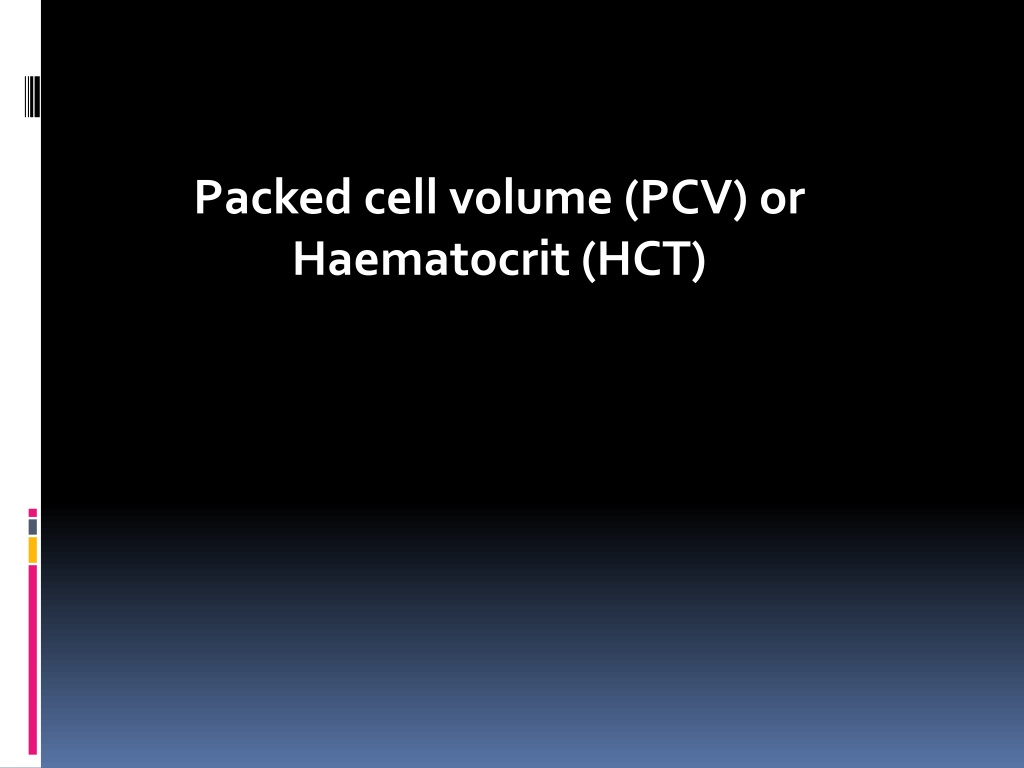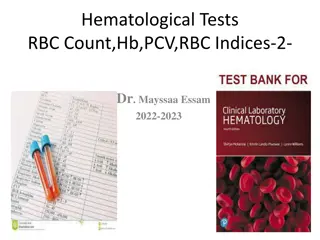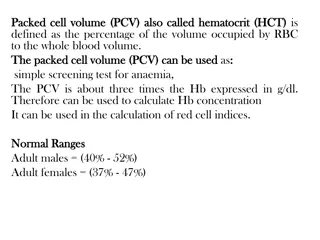Understanding Packed Cell Volume (PCV) and Haematocrit (HCT) Testing
Packed Cell Volume (PCV) or Haematocrit (HCT) is a blood test that measures the volume of red blood cells as a percentage of total blood volume. High or low values can indicate specific health conditions like dehydration or anemia. The test is important in diagnosing conditions like polycythemia. Methods such as Microhaematocrit are used to measure PCV. This guide explains the procedure, normal values, and implications of PCV results.
Download Presentation

Please find below an Image/Link to download the presentation.
The content on the website is provided AS IS for your information and personal use only. It may not be sold, licensed, or shared on other websites without obtaining consent from the author. Download presentation by click this link. If you encounter any issues during the download, it is possible that the publisher has removed the file from their server.
E N D
Presentation Transcript
Packed cell volume (PCV) or Haematocrit (HCT)
Introduction and principle: Whole blood is anticoagulated and centrifuged for maximum red blood cell packing. The space occupied by the red blood cells is measured and expressed as a percentage of the whole blood volume. So PCV: is the volume of RBCs per unit volume of whole blood.
High PCV (haemoconcentration): This may be relative due to reduced plasma volume, or (increased red blood cell mass): absolute Reduced plasma volume - often result of dehydration e.g. alcohol, diuretic therapy, Addison's disease, burns, diarrhea (cholera) and dehydration (because of water loss). Increased red cell mass - primary (polycythaemia rubra vera) or secondary e.g. chronic lung disease, smoking, high altitude, and tumours. Low PCV (haemodilution) either due to reduced RBC mass (anemia) or increased plasma volume e.g. intravenous fluid infusion, pregnancy, acute kidney & liver disease, etc.
Normal Values: Adult male 41 - 54% Adult female 36 - 47% Polycythemia: > 60% in males and > 56% in females Complications of polycythemia: thrombotic events and cardiovascular mortality
Methods of measuring PCV Microhaematocrit Electronic cell counting
Microhaematocrit Material and instruments -Microhaematocrit tube (capillary tube) 75 mm in length and 1mm in diameter which contains heparin and show a red color ring at the end of the tube. -Microhaematocrit centrifuge device. -Plastic seal to seal one end of Microhaematocrit capillary tube. -Microhaematocrit reader.
Procedure: 1- Blood is drawn into the tubes by capillary phenomenon. By holding the tube in a horizontal manner and allow 2/3 - 3/4 of the tube to be filled with blood. Air bubbles denote poor technique but do not affect the results of the test. 2- Seal the dry end of the tube by plastic seal. 3- The sealed tube is then placed in the radial grooves of the Microhaematocrit centrifuge and centrifuge for 5 minutes
4- When looking at a centrifuged haematocrit tube, you can see three distinct layers: top layer of clear slightly milky plasma, thin buffy coat layer (consist of WBC and platelets), and a dark packed RBCs layer 5- Obtain the result using Microhaematocrit tube reading device adjust the movable line to touch the top of the RBCs in the tube (We can measure the PCV by a ruler and we find the percentage of packed cells to the whole column of the sample)
Blood Plasma- 55% Buffy coat- <1% Formed elements-45%
Hematological indices: Mean corpuscular volume (MCV): average volume of a red blood cell. Mean corpuscular hemoglobin (MCH): average content (mass) of hemoglobin per cell. Mean corpuscular hemoglobin concentration (MCHC): average concentration of hemoglobin in a given volume of packed erythrocytes. Red cell distribution width (RDW): coefficient of variation of RBC volume and it is a measure of anisocytosis (abnormal RBC size).
Morphologic classification: Normochromic: normal MCHC Hypochromic: low MCHC Normocytic: normal MCV Microcytic: low MCV Macrocytic: high MCV What types of anemia could be found: Normochromicnormocytic Hypochromicmicrocytic Normochromicmacrocytic Hypochromicmacrocytic
Reticulocytes: immature, larger (macrocytic) red cells that are spherical and have a bluish color (polychromasia) due to free ribosomal RNA. Reticulocytes do not have a nucleus; (note that any erythrocyte with a nucleus in peripheral blood is abnormal). Reticulocyte maturation to mature erythrocyte takes about 1 day. The reticulocyte count is the percentage of red immature cells present in peripheral blood (normal = 0.5 - 1.5%). If there is anemia, it should be taken into consideration and reticulocyte count need to be corrected reticulocyte count takes into consideration the degree of anemia and is calculated as (patient's PCV/45) x (reticulocyte count); the idea behind the calculation is to scale the reticulocyte count by multiplying by the ratio of the patient's hematocrit to "normal" hematocrit of 45%. When interpreting the corrected reticulocyte count, <2% indicates poor bone marrow response and > 3% indicates good bone marrow response.
Classification of anemia can be based on color: Normochromic anemias have normal red cell color (central pallor of about a third the diameter of the erythrocyte); Hypochromic anemias have decreased color (seen as an increased central pallor of erythrocyte); Hyperchrornic anemias (theoretically possible), are usually instead called spherocytosis and have increased color (loss of central pallor of erythrocyte). Classification of anemia can also be based on size (MCV)























